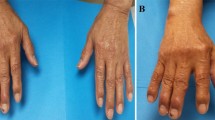Abstract
“A propensity to bend the trunk forward” and “the chin is now almost immovably bent down upon the sternum” were described by James Parkinson in patients with Parkinson’s disease (PD). The term “dropped head” was first reported in “Gerlier disease” in Switzerland and ‘kubisagari’ in Japan and since then also reported in myositis, myopathy, myasthenia gravis, amyotrophic lateral sclerosis, neuropathy, and hypothyroidism. Disproportionate antecollis occurs in about half cases of multiple system atrophy (MSA) and is considered dystonic in nature. Dropped head is considered rare in PD, both in advanced and early stages of PD. However, it is known to progress subacutely over a period of several days. In my experience, dropped head is relatively common in PD. The mechanism of dropped head in PD is either dystonia of flexor neck muscles or weakness of extensor neck muscles. The response of dropped head to various anti-parkinsonian medications is rather inconsistent. Levodopa is reported to induce amelioration in some patients while dopamine agonists can cause deterioration. Muscle afferent block with lidocaine and ethanol is reported to be effective, while the effect of botulinum toxin injection into the affected muscles is limited. The effect of stereotaxic neurosurgery on dropped head is controversial. Early diagnosis and prompt treatment is necessary to prevent muscle damage associated with longterm overstretch of extensor neck muscles.
Similar content being viewed by others
References
Askmark H, Eeg-Olofsson KE, Johansson A, Nilsson P, Olsson Y, Aquilonius SM (2001) Parkinsonism and neck extensor myopathy: a new syndrome or coincidental findings? Arch Neurol 58:232–237
Gerlier (1887) Une épidémie de vertige paralysant. Rev Med Suisse Romande 7:5–29
Gowers WR (1893) A manual of disease of the nervous system, 2nd edition, vol. 2. Blakiston, Philadelphia
Hoffman D, Gutmann L (1994) The dropped head syndrome with chronic inflammatory demyelinating polyneuropathy. Muscle Nerve 17:808–810
Horiuchi M, Uehara K, Kamo T, Sugihara H, Takahashi Y (2001) A case of elderly onset Parkinson’s disease complicated by dropped head syndrome. Jpn J Geriat 38:693–695
Hund E, Heckl R, Goebel HH, Meinck HM (1995) Inclusion body myositis presenting with isolated erector spinae paresis. Neurology 45:993–994
Jorens PG, Eycken MP, Parizel GA, Martin JJ (1989) Antecollis in parkinsonism. Lancet 333:1320–1321
Katz AL, Pate D (1980) Floppy head syndrome. Arthritis Rheum 23:131–132
Katz JS, Wolfe GI, Burns DK, Bryan WW, Fleckenstein JL, Barohn RJ (1996) Isolated neck extensor myopathy: a common cause of dropped head syndrome. Neurology 46:917–921
Lange DJ, Fetell MR, Lovelace RE, Rowland LP (1986) The floppy head syndrome (Abstr). Ann Neurol 20:133
Lomen-Hoerth C, Simmons ML, Dearmond SJ, Layzer RB (1999) Adult-onset nemaline myopathy: another cause of dropped head. Muscle Nerve 22:1146–1150
Matsui H, Udaka F, Kubori T, Nishinaka K, Kameyama M (2004) Parkinson disease with kubisagari. Neurol Med (Tokyo) 61:94–98
Miura K (1887) Uber Kubisagari, eine in den nördlichen Provinzen Japans endemische Krankheit (Gerlier’s sche Krankheit, vertige paralysant, vertige ptotique). Mittheil Med Fac Kaiserl-Japan Univ Tokio 3:259–319
Namekawa M, Fujimoto K, Nakano I (1999) Parkinsonism and dropped head syndrome. Neurol Med (Tokyo) 51:20–25
Okamiya S, Ito H, Saito T, Kowa H, Torii J (1997) A case of isolated neck extensor myopathy with parkinsonism. Rinsho Shinkeigaku 37:393–396
Parkinson J (1817) An essay on the shaking palsy. Whittingham and Rowland, London
Quinn N (1989) Disproportionate antecollis in multiple system atrophy. Lancet 333:844
Quinn NP (1993) Parkinsonism and dystonia, pseudoparkinsonism and pseudodystonia. In: Narabayashi H, Nagatsu T, Yanagisawa N, Mizuno Y (eds) Advance in Neurology 60, Raven Press, New York, pp 540–543
Riggs JE, Bodensteiner JB, Schochet SS (1994) The dropped head sign: an unusual presentation of congenital myopathy. J Child Neurol 9:330–311
Suarez GA, Kelly JJ (1992) The dropped head syndrome. Neurology 42:1625–1627
Waclawik AJ, Lotz BP, Beinlich BR, Brooks BR (1997) Dropped head syndrome. Neurology 48:550–551
Yamada H, Katayama Y, Yamamoto T (2003) Parkinson’s disease and dropped head (Abstr). Rinsho Shinkeigaku 43:955
Yoshiyama Y, Takama J, Hattori T (1999) The dropped head sign in parkinsonism. J Neurol Sci 167:22–25
Author information
Authors and Affiliations
Corresponding author
Rights and permissions
About this article
Cite this article
Fujimoto, Ki. Dropped head in Parkinson’s disease. J Neurol 253 (Suppl 7), vii21–vii26 (2006). https://doi.org/10.1007/s00415-006-7006-3
Issue Date:
DOI: https://doi.org/10.1007/s00415-006-7006-3




